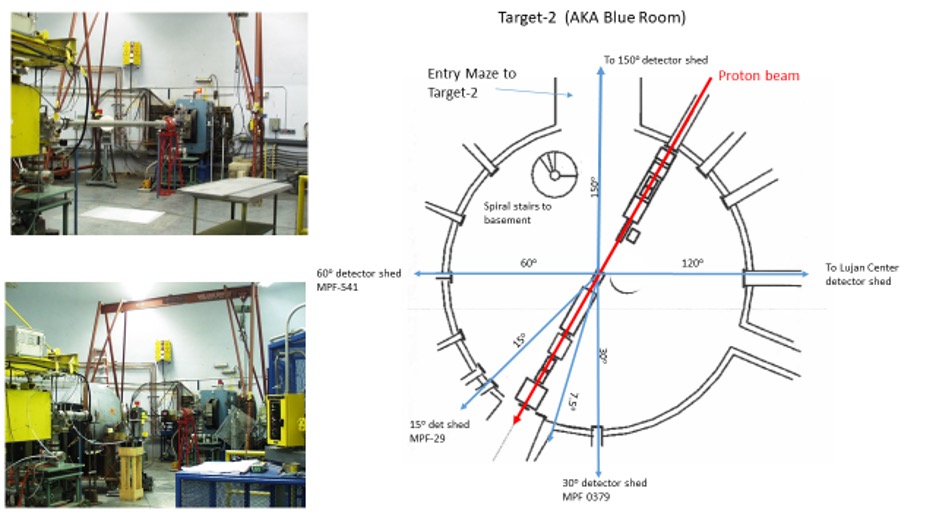Target 2 - Blue Room at LANSCE
Target 2 provides experimenters direct access to the LANSCE proton beam. It is used for proton irradiations, measuring proton-induced reactions and the development of specialized neutron sources.
Target 2 - Blue Room
The Blue Room is located in Building MPF-7 at LANSCE. It is a domed room with a diameter of 40 feet with 6 flight paths radiating from the center of the room to detector sheds outside the room at a distance of up to 50m. The main floor of the Blue Room is constructed primarily of aluminum and elevated 20 feet above the basement floor to minimize neutron wall return for experiments sensitive to such effects. The proton beam enters the Blue Room from the northeast and then exits to the southwest on its way to Target 4. During Target 2 operations, the beam line is removed in the middle of the Blue Room and experiments are installed at the center of the room in the path of the beam. Approximately 4 m of space along the path of the proton beam is available for experiments.
Target 2 can use either the LANSCE linac beam directly, or the high peak intensity of the stacked beam from the Proton Storage Ring (PSR). The linac beam to the Target 2 can normally be operated with up to 80 nA with time substructure available for experiments that require it. Normal linac operations provide 800 MeV protons, but the facility is capable of delivering protons with energy from approximately 250 MeV to 800 MeV. Each proton micropulse from the linac is less than 1 ns wide and contains approximately 6 x 108 protons.
The PSR beam can be transported to Target 2 when intense proton pulses are required. Unless there is additional shielding in place, the average current is still limited to 80 nA. The PSR can run in a pulse-on-demand mode. PSR beam pulse intensity can be as high as 5 mC (3 x 1013 protons) per pulse.
Because the proton beam is transported through Target 2 to get to Target 4, the neutron production target, Target 2 can only be used by turning off beam to Target 4 and all its associated flight paths. If the PSR beam is used in Target 2 it will turn off beam to Lujan Center. Because of these constraints, use of Target 2 is scheduled only for the highest priority experiments.
The proton current is measured using a Bergoz Integrating Current Transformer (ICT) with appropriate sensitivity in the range of proton currents required by the experimenter. The area of the beam spot is measured by taking an image of a phosphor placed in the beam.
Figure 1 shows the layout of Target 2. The pictures are viewed from the entry maze. The upper left picture show Target 2 with the beam transport pipe in place. The yellow box on the lower left of the picture is the current pickoff used by the accelerator operators (1RCM01). The blue magnet is the Lorraine beam magnet which bends the beam upwards 8.25o to Target 4. The lower picture is with the transport pipe removed and an open area exits for experiments to place their experiments. When experiments are place in this position, the beam is usually stopped in a 30 cm diam and 150 cm long cylinder of carbon.
Because Target 2 is considered a primary beam area, activation levels may be high so special procedures may be required.

Figure 1. General layout of Target-2 showing the various flight paths.


